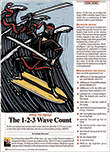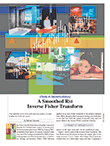 Editor,
Editor,I am really enjoying Sylvain Vervoort’s recent series of articles on his indicator rules for a swing trading system (IRSTS). The series is excellent and refreshing. I am taking it slowly and one step at a time.
LETTERS TO THE EDITOR
The editors of S&C invite readers to submit their opinions and information on subjects relating to technical analysis and this magazine. This column is our means of communication with our readers. Is there something you would like to know more (or less) about? Tell us about it. Without a source of new ideas and subjects coming from our readers, this magazine would not exist.
Address your correspondence to: Editor, Stocks & Commodities, 4757 California Ave. SW, Seattle, WA 98116-4499, or E-mail to editor@traders.com. All letters become the property of Technical Analysis, Inc. Letter-writers must include their full name and address for verification. Letters may be edited for length or clarity. The opinions expressed in this column do not necessarily represent those of the magazine. —Editor
Editor,
What’s the newest craze in commodity trading? Going back to basics, as Ronald Stuart requested in his letter to S&C in your August 2013 issue.
I have been teaching the basics of trading for more than 10 years. I am now semi-retired from trading, but when I started trading in 1984, I read Commodity Perspective magazine. Each day, I filled in charts by hand. Each day, the tally sheet would come in the mail and you had three days to correct any mistakes. Those who were traders did better, as each trade had to be written down and checked against the broker’s sheet that was mailed. There were only three data suppliers then. But my old Epson 286 with a math coprocessor was great, as was my CQG data via satellite on a monochrome screen. All orders had to be called in via phone. The library had only two dozen books on its shelves about trading, and most were historical charts. I sent away for free booklets from brokers that advertised in the Wall Street Journal on “how to place an order” — yes, we had to place orders by phone in a specific wording order.
I received several booklets that I still keep next to my desk today, from Lind-Waldock, the CME, CBOT, and works by Jake Bernstein, Larry Williams, plus a few inept how-to books on technical analysis. Then I came across George Lane and stochastics, and next J. Welles Wilder’s book. From then on, I was a tiger, making up to 50 trades a day.
I now teach. I’ve taken dozens of classes over the years — several from George Lane himself. I am a bit partial since he developed stochastics while at the University of Michigan and I am a Michigander. He used a Univac in 1955–57 that took up a room as big as my living room today. Today, our cell phones have more computing power than that Univac did. From many of the classes and seminars that I have taken, it seems that no one really knows how to use stochastics. Calculating it by hand, as well as making a “jig” to do backtesting, was work. A “jig” is a template; after taping several years of Commodity Perspective together on the wall, I would trace back the algorithm I was backtesting via the template and see if my calculations worked. Today, people think the computer will do it all for you.
I teach people how to think! How to decide for themselves! A “composite trader” (as Golden Gate University professor Henry Pruden put it) is a trader who thinks for himself. If you are not on top of your game, then you need potty training (as trading coach Adrienne Toghraie put it). If you need a system, Martin Pring’s book Technical Analysis Explained states in chapter 8 that a simple moving average is one of the best indicators. I have now read hundreds of books, taken dozens of classes, thrown out dozens of boxes of daily logs, kept calendars such as the ones attorneys use, made hundreds of spreadsheets (the old way — by the numbers, not a graph-style chart). Yes, the old paperwork is a burden to schlep around when you go to move, and besides, the final numbers are all in the tax returns.
Everyone should remember that trading is work — a job — and should not be done from home. In a sense, the trader becomes a broker for his system! Yet a trader also must be a blackjack player of sorts and know when to double-down.
I don’t believe in disclaimers, although I have to have students sign one. I believe that if you are old enough to look both ways before crossing the street, then you are responsible for your own trading.
I can be reached at chartistllc@yahoo.com, in the middle of corn and bean country.
Arnold Shenkman
Clinton, MI
Thank you for sharing your comments and insights. As this magazine celebrated its 30-year anniversary last year with the October 2012 issue, our article “A 30-year Lookback” also reminisced about many of the changes that have taken place in the markets over the years and the way computers have changed the way traders trade. That article can be found in our article archives at www.traders.com.
As for going back to basics, we agree that even as computers allow for more and more sophistication, and markets get more complex, the basic tenets of technical analysis that seek to analyze supply & demand are still at the heart of it all, and students of the markets would do well to gain a good foundation before putting hard-earned money on the line.
And speaking of treating trading as a job, Jerry Cartwright in his article in this issue, “Trading As A Business,” concurs with you.—Editor
 Editor,
Editor,
I am really enjoying Sylvain Vervoort’s recent series of articles on his indicator rules for a swing trading system (IRSTS). The series is excellent and refreshing. I am taking it slowly and one step at a time.
I have plotted an hourly chart of the euro spot price in NinjaTrader and am working with Vervoort’s zigzag indicator. I am trying to get used to wave counting.
On page 14 on the June 2013 issue (“The 1-2-3 Wave Count,” which is part 2 of his IRSTS series), Figures 5 & 6 shows divergences using an indicator on the bottom pane study. Could you let me know what this study is? Is that yet to be published? Or is it a simple oscillator such as an RSI? Any help would be much appreciated. Once again, excellent article!
P.S. My zigzag percentage is set to 1. The ATR period is also 1 and the ATR factor is set to 1.5. Is it best to set “autoscale” to true?
Mario Fernandes
Ascot, UK
Author Sylvain Vervoort replies:
Thank you for your kind words.
The oscillator in the bottom pane is a smoothed Percent b oscillator, which was covered in “Oscillators, Smoothed” (Stocks & Commodities, September 2013) as part 5 of my series. You’re probably familiar with the Percent b (%b, or PB) oscillator, developed by John Bollinger. Here’s how it works: When the price touches the upper Bollinger Band, then the oscillator hits 100. If price moves above the upper band, the oscillator moves to +100. When the price touches the lower Bollinger Band, then the oscillator hits zero, and if price moves below the lower band, the oscillator moves to a negative value.
For the hourly chart, I would use (more or less) the values 0.6, 5, and 0.6 to see more intermediate waves. But it all depends what you want to see. For the ATR period, you should use a minimum of 3. Autoscale does not matter, since the zigzag is attached to the price. It’s probably best to set it to false to avoid additional computer calculations.
 Editor,
Editor,
After reading Sylvain Vervoort’s article from your archives “A Smoothed RSI Inverse Fisher Transform” (October 2010), I have a question about using the indicator. Vervoort mentions to install the external Forum.dll file that has a function for a dynamic moving average. How do I go about installing the file? I use MetaStock.
I know MetaStock supports your formula, but are there also other programs that support your formula?
Andrew
Author Sylvain Vervoort replies:
Under the \MetaStock\ folder on your hard drive, there’s a folder called “External Function DLLs.” You simply have to copy the file “Forum.dll” into this folder.
You will find the formula for other software at the Stocks & Commodities website, Traders.com, in the Traders’ Tips area for TradeStation, eSignal, Wealth-Lab, AmiBroker, NeuroShell, AIQ, TradersStudio, Tradecision, NinjaTrader, TickQuest, Wave 59, Updata, and VT Trader. Search on the term “smoothed RSI inverse Fisher transform” at Traders.com